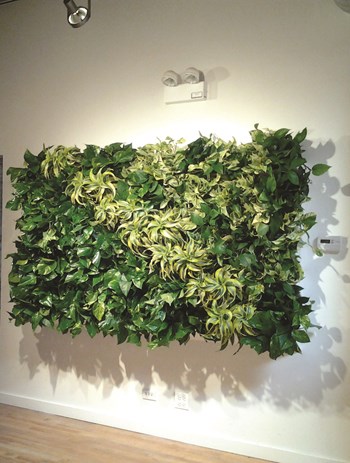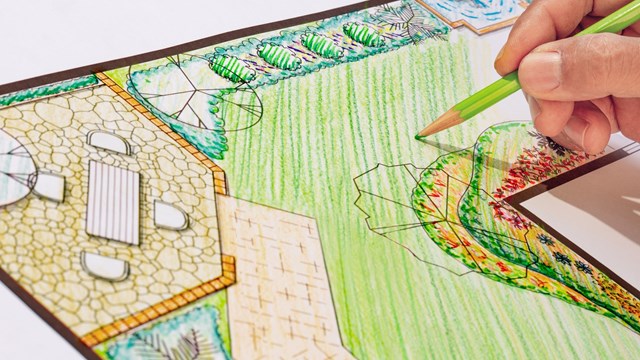
A green wall in a residential space is like having both an indoor garden and piece of art all rolled into one--and you don’t even have to travel far to a botanical garden or a museum to experience it. It’s a currently a very popular trend in landscape design in which walls are covered with plants and can be found these days in some businesses, public spaces, and homes.
Not only will green walls (also known as living walls or vertical gardens) appease the conservation-minded, but they also provide an opportunity for boards and managers to think about how they could spruce up their lobby or common area. Installing a green wall in a residential building is sure to be a conversation piece between tenants and visitors, but there are definitely things to consider before embarking on such an undertaking.
The Benefits of Green Walls
Those who specialize in green or living walls agree that the major advantage of having them is purely environmental, in addition to freeing up more space compared to traditional floor plants. “There are lots of benefits in terms of purifying the air,” says Jean Berg, general manager of Phillip’s Interior Plants and Displays, located in Oak Brook, Illinois. “A lot of places have lots of toxins that plants can purify and clean the air.”
And there is also a psychological benefit from green walls that is mood enhancing, according to Molly Meyer, founder and CEO of Omni Ecoystems, based in Chicago. “People are happier with plants around,” she says. “There's lot of studies in this field called biophilia that show that humans are happier and healthier when they can see and experience and interact with greenery.”
Anthony Caggiano, owner and president of Plant Connection, Inc., located in Riverhead, New York, notes that green walls can reduce the “heat island effect.” This sort of wall acts as a layer of insulation, keeping a building cooler in the summer and warmer in the winter, as it “insulates and cools the building envelope, as well as protecting it from the elements.”
There is also the positive impact that green walls have on reducing noise, according to Dave MacKenzie, horticulturalist and inventor of LiveWall, based in Nunica, Michigan. “Plants, soil, trapped air, and moisture in the soil are great acoustic insulators,” he explains. “Studies have shown that green walls can reduce ambient noise by up to 40 decibels, an important benefit to those who work or live close to noisy streets, highways and airports.”
Setting, Pests, Costs: What to Consider Before Installation
Boards or homeowners associations who are interested in installing a green wall (which could consist of panels or trays, according to national landscaping company Ambius) in their common space should think about the structural factors involved, including whether you want the vertical garden mounted on the wall or make it a freestanding structure.
According to Berg, it is deciding what system that you want to use. “There are from the simplest,” she says, “which is a tray system that doesn't need any cooling or [electricity]. They're just trays that fit or go on the wall. With that, you just need to make sure that the wall could support the weight that you're putting on the wall. If you're going to go a different route and use maybe a freestanding wall, that needs [electricity] because it has a recirculating pump, and you need to make sure you have an electric outlet somewhere”
Of course, there is irrigation to be considered as well. "Living wall plants need to be watered,” says Meyer. “Generally that involves an automated irrigation system, which can either be connected to the city water supply by a plumber or to stationary or mobile water tanks." Along with watering are lighting conditions for the plants. “It is possible to grow certain plants in a completely artificially-lit environment,” Meyer says,” but that needs to be planned out in advance so the proper lights can be installed to keep the living wall healthy. The other side of that coin is too much light can be difficult for some plants too.”
Also to note, green walls are not immune to the problems of attracting pests such as insects. “As wacky as it sounds,” says Meyer, “there can be tiny little mites that are on someone's clothes or boots, or even in an unwashed salad that someone brings into work one day or to the lobby. There could be little tiny things that jump into the plants. Expanding the plant palette is possible, but what it means is ongoing maintenance routine is heightened.
“Plants and bugs go together. It doesn't mean you'll have insects, but it's possible,” adds Berg. “And especially if they're not watered properly, insects can flourish in a stressful plant environment. That's why you want to have professionals taking care of it. If plants are overwatered, you're going to create an environment where you could have some mold issues.”
The costs involved in putting up a green wall could depend on such things as the size of the structure, the type of system, and the plants used. “That cost can be very inexpensive like the tray system,” says Berg, “or very expensive [like] some of these self-contained, self-irrigating systems. You can spend hundreds of dollars or thousands of dollars. And then you have plants to purchase as well, and then there's labor to install it. Again that can be very simple with the tray system or more complicated with some of the more sophisticated systems that exist. We try to understand what people's budgets are going into it because that could dictate what's feasible for you. And there's regular upkeep to it as well.”
“Also, do additional lights need to be added or additional plumbing need to be brought to the wall?” says Meyer. “Those factors to contribute to the costs of the wall. And then the size: A small wall is more per square foot than a big wall would be. [The price range] is anywhere from maybe $125 to $200 a square foot, depending on that matrix of factors.”
Plant Types That Do Well in a Green Wall
There are certain plant types that perform well in a green wall, depending on the type of wall and the environment, according to Berg. Among those she lists as ones that are good for green walls include some ferns (i.e. bird’s nest and Austral Gem); pothos (i.e. jade, golden, marble and neon); Dracaena Janet Craig compacta; varieties of Ficus Decora (i.e. ruby); and varieties of Fittonia. On the flip side, plant that can underperform in a living wall include Boston ferns; varieties of Dracaena Warneckei; and Algerian and English ivies.
“Plants that do really well on a living wall would be tropical plants that you would typically see in a tropical climate,” adds Meyer. “And they're generally low light plants as well. These are commonly house plants like spider plants, pothos, philodendron, and Dracaena. Those are four very common plants used in living walls.”
From Planning to Build-Out
Installing a green wall usually begins with a consultation between the green wall specialist and the client, which can include an inspection of the site. “We would meet with the client and determine what they are trying to achieve,” says Berg, “where they’re thinking, whether that structurally will work, what that space looks like. That will determine what kind of systems to utilize based on budget. Then we will design the walls with the containers and/or the plants, and then we install it, depending on the size and the type of systems. That can take an hour or all day.”
“The process for planning and building a living wall starts with meeting the client to discuss design goals and budget and visiting the space to understand site conditions, meaning the structure, the lighting, the plumbing, etc.,” says Meyer. “With that information, we prepare a proposal for the design and execution of the client's vision.
“After that, we get into the nitty gritty of design, where we layout where each plant will go and how the living wall will look,” she continues. “Once the layout is approved, then we grow out the plants in our living wall panels. The growing takes at least three months.
“Then they are shipped to the site. Our installers prepare the space, hang the living wall panels and connect them to their water source. The installation is a pretty quick process. The actual installation for a small living wall would take a day, larger ones maybe up to a week. Once installed, the living wall is there to grow and be enjoyed.”
Taking Care of Your Green Wall
The companies that installed the green walls will usually drop in for the occasional maintenance visit. “On average it's about once a week that plants are watered,” says Meyer. “And every two weeks we do what we call a full maintenance visit. What that entails is maybe pruning the plants if they've gotten long, or picking off yellow leaves that might have died. We dust the plants and check the soil health or address pest issues that come up. Those series of visits are for rest of the life of the living wall as long as it's in that space.”
“They do need career and regular care, cleaning, pruning and obviously watering, sys Berg. “The watering could either be hand watered if it's a tray system, meaning a self-contained tray that's got a slope to it and hangs on the wall. Or if it's one of these circulating systems with [electricity], it's a matter of filling that tank to keep enough water in there to recirculate, and that timer may go off any time of day or maybe go off once every other day. So that's something that needs to be set up based on light and the environment.”
With proper maintenance, a green wall will ultimately bring a fresh and beautified look to a building’s lobby or common area that goes a step beyond decorating it with a potted plant, a vase or a painting--while at the same time contributing to the good of the environment. A building’s own vertical garden is sure to make tenants and visitors stop and observe it.
“A lot of times, green walls look more like art,” says Berg. “You can create different color patterns with the foliage and create more of a piece of art on the wall versus just plants on the wall.”
“They add to the aesthetic of a space,” says Meyer of living walls. “Certainly there are living walls that can make artistic statements.”
David Chiu is an associate editor of The Chicagoland Cooperator. Additional reporting by freelance writer Greg Olear.






Leave a Comment